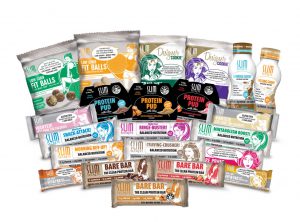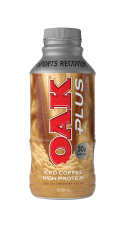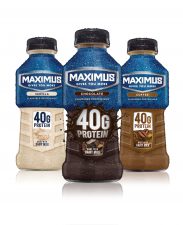
Protein powders and supplements used to be a niche product, catering to hardcore fitness fanatics and people seeking to lose weight. But protein is an essential nutrient for everyone, and consumers have long sought out protein in forms other than the traditional source, red meat.
As a nutrient, protein is essential for muscles during the recovery process, post-workouts as it builds and repairs tissue. It is also filling and promotes heart health, which is a necessity for people undertaking a weight-loss program.
Consumers want to be able to get their protein in a convenient and easy-to-consume package: protein bars and liquid breakfasts are at the forefront of the protein category for C-stores looking to meet this demand. After all, eating a piece of steak or chicken in your car after a workout to build and replenish muscles just isn’t practical.
As consumers continue to become more educated about the nutrients in their food, thanks to greater availability of information about the market, the growing interest in protein bars and beverages has led to both supermarkets and C-stores stocking the potential high-margin category as an alternative to conventional sugary and high-carbohydrate snacks. As always, the market is changing: consumers often seek out products fortified with protein in order to feel full for a longer period of time, without having to eat a standard meal.
Bulking up and building muscle
With the growing trend of high protein-based foods filling the gap in the market, retailers need to know how to capitalise on that trend and provide consumers with the products that are in demand.
The convenience channel is the ideal market for protein bars, as they meet the needs of portability and an ease of consumption as a grab-and-go product that consumers expect from a C-store purchase.
Many other companies have seen the gap in the protein market and sought to produce suitable products. Slim Secrets director Sharon Thurin said “Healthanism” is on the rise: consumers who are looking for a guilt-free, healthy indulgence.
“They’re searching for products that have it all,” she said. “They want products that taste great but also have less of the added ingredients such as excess sugar, artificial flavours, colours, and preservatives.”
“It’s about going back to basics, using real, less-processed ingredients that you would have in your pantry, but lack the knowledge or time to prepare.”
Slim Secrets’ ‘Ready to Drink’ protein shakes don’t require mixing powders or the addition of water, and its pudding-style snack ‘Protein Puds’ come with a spoon, making them perfect for the grab-and-go customer.
Ms Thurlin said the brand had increased ranging and achieved better positioning in the convenience sector over the last six months, as consumers come to demand more of these healthier alternatives.
 OAK also capitalises on the key gap in the protein product market, and using the company’s knowledge of its target market (hungry-thirsty is often identified), it has brought OAK Plus to offer a protein-supplemented milk tailor-made for the convenience channel.
OAK also capitalises on the key gap in the protein product market, and using the company’s knowledge of its target market (hungry-thirsty is often identified), it has brought OAK Plus to offer a protein-supplemented milk tailor-made for the convenience channel.
OAK marketing director Angela Burr said many people like to drink OAK after exercise because of its protein and nutritional benefits.
“OAK Plus tastes every bit as good as regular OAK, but is designed specifically to refuel the body after a tough workout, with 30 grams of natural dairy protein for sustained energy and muscle recovery throughout the day,” she said.
‘Wheyt’ lifting
Protein helps muscle recovery in the post-workout phase, and as such, retailers need to capitalise on the fitness trend followed by gym-junkies and other protein supplement consumers. Manufacturers need to be aware of that customer base, and use the knowledge to develop their range and product offer, which in turn will be passed to the retailers. For example, all of the Slim Secrets products are formulated to include the right balance of carbohydrates, fats and proteins. In addition to this, Slim Secrets knows their customers base well; 70% female to 30% male, a divide which alerted them to the need for innovative new ways to reach male consumers.
Protein drinks are ranked third as a shopper’s main reason to go shopping; it is also a key category in shoppers choosing where they will shop, Shopper Tracker revealed. The research group suggested that retailers would benefit from communicating promotions outside of the store; shoppers will spend more in-store through volume deals, trying new products, as well as paying a premium for a better quality product.
This rings true for C-stores, as petrol and convenience shoppers are usually in a rush. As a result, stores only have a small window of time to capture their attention. Packaging and eye-catching POS material is also crucial to help emphasise the health benefits and trigger extra impulse sales.
Milk nutrition for thirsty-hungry consumers
The Australasian Association of Convenience Stores (AACS) 2016 State of the Industry Report acknowledged that milk nutrition products address the “thirsty-hungry” needs state.
The thirsty-hungry state occurs in consumers, feeling neither specifically hungry nor thirsty, but rather a mix of both. Milk drinks and milk-based protein supplements are sold as a simple solution to this recently identified craving phenomenon.
Ultra-High Temperature (UHT) milk nutrition, also called ‘meal replacement’, offers a filling on-the-go option. The milk nutrition segment has been one of the strongest performing segments for two consecutive years across 2015-16, with Sanitarium products leading the charge.
In 2016 Sanitarium’s dollar growth rose by 13%, its products being one of the main drivers behind the category’s strength and improvement. The AACS report showed that one-in-five Australians purchased a liquid breakfast replacement from non-grocery channels in that period.
Sanitarium’s Up&Go is a quick and easy breakfast replacement that offers healthy sustenance, and controls a massive 62% of the volume share in the purpose-drinks category, as people increasingly lean towards on-the-go purchases. 69% of Up&Go purchases made in 2016 were from petrol and C-stores, for immediate consumption.
A spokesperson for the recently-renamed beverage major Frucor Suntory said that the milk nutrition category in Australia has doubled in the past six years, to reach a value of $33 million each year.
“Seeing an opportunity to grab a stake in this category, Frucor developed a new offering under the established Maximus brand: Maximus Protein Milk,” the spokesperson said.
“Maximus was initially launched in the isotonic sports drink category in 2013. Since then, the brand has become well known in its target market for its value for money, product efficacy, quirky limited edition offerings and provocative marketing campaigns.
 “Maximus Protein Milk is true to its brand promise of “Gives you More” with 40g of casein and whey protein in each serve.”
“Maximus Protein Milk is true to its brand promise of “Gives you More” with 40g of casein and whey protein in each serve.”
Senior brand manager Christine Dasey said the bottle design of Maximus Protein Milk provided a distinctive offering to enter the milk nutrition category.
“Within our BP and Caltex test market, Maximus Milk was driving 53% of category growth [Aztec Scan Nov 16] so we know we’ve got a solid product offering,” she said.
With such high growth in the protein segment, retailers should take note of this trend in grab-and-go and manage stock accordingly. The ease of purchase and consumption of protein supplements and beverages makes for an easy sale to customers if the products are easily accessible within store and effective marketing and signage is used to gain the attention of the customer.

